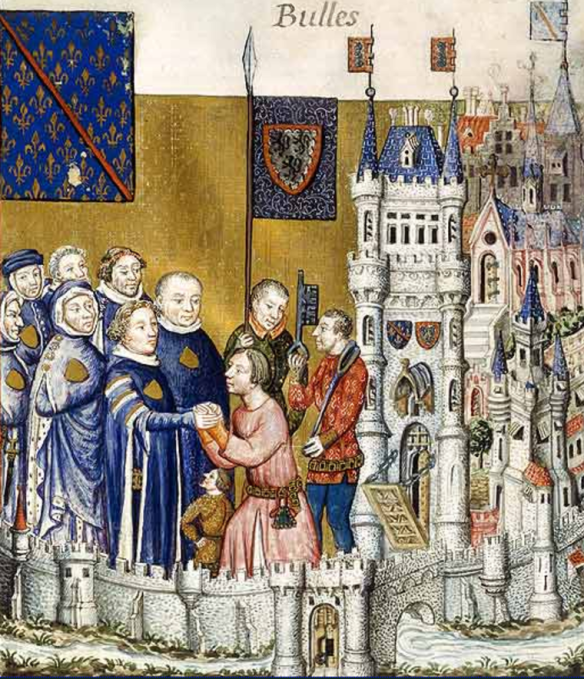Military historians have usually taken a more restricted view of feudalism. For them, it is the system of raising troops in which a lord grants a fief-typically a piece of land-to a vassal (Latin vassus). In return, the vassal gave the lord a defined and limited term of military service, usually forty days a year and usually as a knight-a fully armed and armored horseman. Sometimes the lord provided the armor and weapons, but often the vassal provided his own. The fief was the payment for service and was also known as “the knight’s fee.” Feudalism in this sense has often been taken as the sign of a weak central authority with limited cash resources, forced to substitute land for cash and to devolve local power to its aristocracy; in fact feudal is often used simply as (somewhat misleading) shorthand for “decentralized polity dominated by a powerful warrior aristocratic class.” But not all decentralized polities raised troops using land-for-service arrangements, nor were all polities that did utilize such arrangements weak, poor, or decentralized.
Indeed, these arrangements did not even characterize what has been regarded as the prototypical feudal society of northwestern Europe from the ninth to the twelfth centuries. Recent research has traced modern conceptions of feudal service to the terms and definitions of the Libri Feudorum, an Italian legal handbook written in the twelfth and thirteenth centuries. Its academic view of fiefs and vassals became the basis for the sixteenth-century interpretations of feudal institutions that have held sway ever since. However, this picture of feudal service and the legalistic hierarchy of landholding rights associated with it does not fit the medieval evidence. Feudum and vassus were vague and mutable terms, and European military systems from the ninth to the fourteenth centuries were far more varied, flexible, and rational than conventional interpretations have supposed.
Restricted service in return for granted land was inherently limited as a basis for a military force-leaders always needed soldiers available for more than forty days a year, at the least-and this system has been overrated as the source of medieval European armies. Soldiers did serve for land, but often they were “household knights”-young men who lived with their lord and served him in military and nonmilitary capacities-who were rewarded for long service with land of their own and served in anticipation of this reward. Even service for land already granted was far less defined and restricted than the traditional “forty days a year” formula implies. “Feudal” service (unpaid service by the vassals of a lord) worked best on an informal basis: a lord in need of armed support in his local disputes and in serving his own lord (if he had one) called together the young men who were his friends, relatives, hunting and drinking companions, and social dependents, and they campaigned together, sharing the risks and rewards of warfare. Social cohesion in the lord’s military household (Latin familia) translated into military cohesion, and constant hunting and fighting together imparted small-unit skills. Restrictive and legalistic terms of service played almost no role in such arrangements.
There are also problems, however, with defining feudalism more generally as a landed support system for unpaid military service. First, individuals and groups also served for pay in medieval Europe from an early date, wherever economic conditions made it possible and even when they owed “feudal” service. Paid service became increasingly common in the period after 1050. Second, in a global context there have been many forms of “soldiers’ lands” in different times and places, in combination with paid and unpaid service. Some involved the granting, not of possession of a particular piece of land, but of income rights over the land. Income rights were often, in fact, granted from several different pieces of land. Arrangements such as these, which entailed no direct link between the military manpower supported by landed income and the peasant manpower working the lands, differ fundamentally in type from arrangements in which the warrior who was granted the land assumed legal control over the peasant population and managerial control over the output of the estate. Indeed, in some cases the military manpower supported by designated “soldiers’ lands” was not in a position of social and political dominance-it was not, in short, a warrior aristocracy, but instead constituted a sort of militia. Arrangements such as these also differ in type from those that were set up for a dominant warrior elite. Therefore, to call all land-for-service systems of supporting military manpower “feudal” is to arrive again at an overly broad definition, akin to the problem of the Marxist definition of feudalism, which makes no useful distinctions between systems and their individual characteristics. To try to distinguish some such systems as “feudal” while excluding others has inevitably involved privileging the characteristics of the European model in order to arrive at criteria for inclusion, for no reason than that it was studied (and called feudal) first-a pernicious instance of Eurocentrism. Military historians are thus increasingly avoiding the term, and are turning instead to functional descriptions of the world’s (and Europe’s) varied military systems of landed support, militia service, and the social hierarchies that accompanied them.
